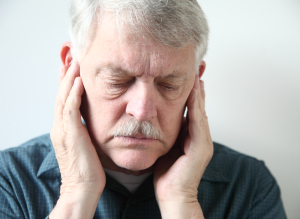Introduction
TMJ is the short connotation for “temporomandibular joint”. A dysfunction of the TMJ is a common problem in the general population.
It is associated with internalized subconscious tension and stress. It is one of the psychosomatic diseases, where the patient may deny that there is a connection between the body and the mind.
However, during the night the patient may be grinding teeth and clenching the jaw, which irritates the chewing muscles and makes the temporomandibular joint irritated and swollen. Eventually, when this happens night after night and later also during the day, the chewing muscles tire out and get into prolonged spasms.
This in turn leads to pain in the jaw area and a vicious cycle is established. Prolonged jaw clenching and teeth grinding (medically termed “bruxism“) can affect the enamel of the molar teeth, lead to premature degenerative changes of the temporomandibular joint, and in time even to a chronic pain syndrome.
Signs and symptoms
There is usually a chronic gnawing pain on one side of the jaw, which may also be felt behind the eyes and ears,the neck and sometimes also in the shoulder area (Ref. 5, p.1145). There is often some clicking in the affected jaw and an inability, particularly in the morning to open the jaw wide. The chewing muscles are tender to touch, chewing is painful and makes symptoms worse. At times there might be locking of the affected jaw. The doctor has to exclude other illnesses such as middle ear infection (otitis media), parotid gland stones and polymyalgia rheumatica and temporal arteritis.
Diagnostic tests
Often no tests need to be done as a thorough physical examination can give the physician a good indication whether anything is seriously wrong.
However, in the more chronic cases that do not respond to therapy, the test of choice is an MRI scan of the jaw. This has the advantage that it shows all the anatomical details of the temporomandibular joint including a very mobile small disc that needs to move smoothly with opening and closing of the jaw. When there is locking or clicking, there is usually a certain degree of impingement of this small disc inside this joint. The MRI scan can depict this. However, often all of the anatomy is normal and the patient still is symptomatic. This is good news, but it is difficult at first to explain the normal finding to the patient.
TMJ (Can Be A Cause Of Headaches)
Treatment
About 75% of patients will respond to a combined therapy consisting of physiotherapy treatments with ultrasound and icepacks and restrengthening of the jaw muscles.
Cognitive therapy is the other important part of therapy. Biofeedback may be helpful along with this as reality will set in when the muscle tension of the chewing muscles is made audible. Self hypnosis tapes may be beneficial to help to get a deeper, more restful sleep with less tooth grinding. A mouth guard for grinding teeth can be custom made by a dentist with an interest in TMJ disease. This is worn at night time. When molar resurfacing may have to be done, it is time to likely have at least an assessment done by an oral surgeon to see whether there are any structural bite changes. Antidepressants at bed time also can be helpful regarding the depth and relaxation during the sleep. Those patients who do not respond (the other 25%), should be seen in a multidisciplinary university based center for temporomandibular joint dysfunction (Ref. 5, p. 1146).
References:
1. Goldman: Cecil Textbook of Medicine, 21st ed.,2000, W. B. Saunders Company
2. B. Sears: “The top 100 zone foods”. Regan Books, Harper Collins, 2001.
3. The Merck Manual, 7th edition, by M. H. Beers et al., Whitehouse Station, N.J., 1999. Chapter 176.
4. Noble: Textbook of Primary Care Medicine, 3rd ed.,2001, Mosby, Inc.
5. Goroll: Primary Care Medicine, 4th ed.,2000, Lippincott Williams & Wilkins
6.Rosen: Emergency Medicine: Concepts and Clinical Practice, 4th ed., 1998, Mosby-Year Book, Inc.
7. Ruddy: Kelley’s Textbook of Rheumatology, 6th ed.,2001, W. B. Saunders Company
8. Ferri: Ferri’s Clinical Advisor: Instant Diagnosis and Treatment, 2004 ed., Copyright © 2004 Mosby, Inc.
9. Rakel: Conn’s Current Therapy 2004, 56th ed., Copyright © 2004 Elsevier
10. Suzanne Somers: “Breakthrough” Eight Steps to Wellness– Life-altering Secrets from Today’s Cutting-edge Doctors”, Crown Publishers, 2008







